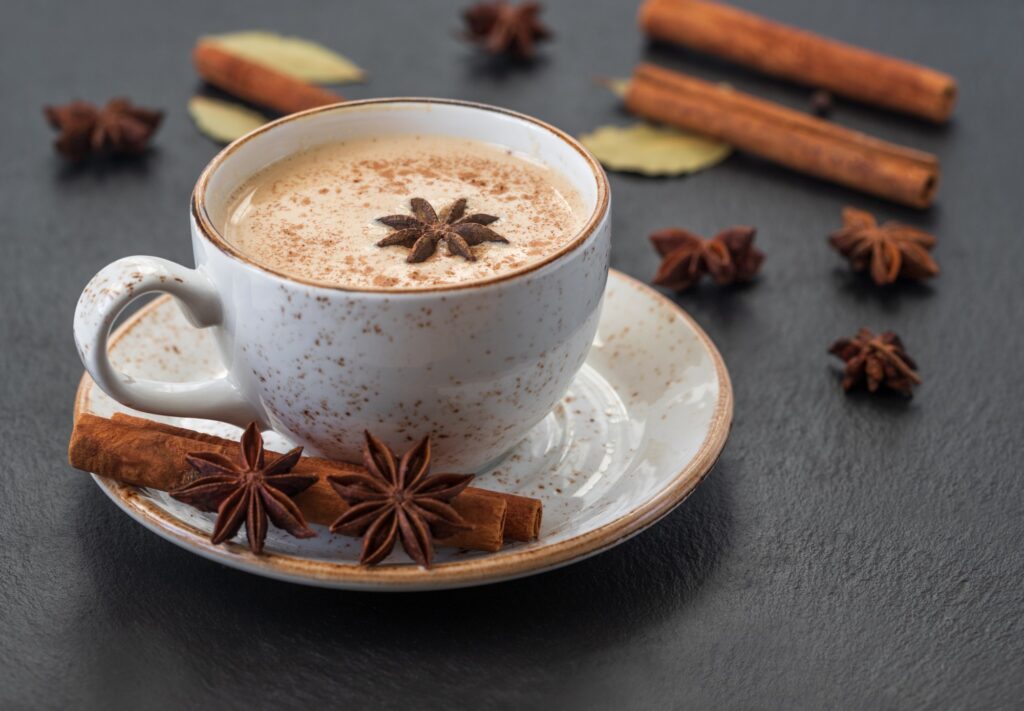
Indulge in the enchanting flavors and captivating aromas of authentic chai with our guide on how to make the perfect cup at home. With every sip, transport yourself to a world where spice-infused tea reigns supreme, tantalizing your senses and soothing your soul.
Join us on this aromatic journey as we delve into the art and science of crafting authentic chai at home. Your mornings will never be the same again. Get ready to awaken your senses and embrace the richness of this beloved beverage. Let’s dive in!
The origins of chai
Chai, the word derived from the Chinese word “cha,” meaning tea, has a rich and fascinating history. Its roots can be traced back to ancient India, where it was traditionally consumed for its medicinal properties. Chai was initially made using a blend of herbs and spices, believed to have various health benefits.
Over time, chai evolved to include the addition of tea leaves, making it the beloved brew we know today. With the influence of different regions and cultures, chai recipes began to vary, each offering a unique flavor profile and aromatic experience.
The different types of chai
Chai comes in various forms, each with its own distinct characteristics. One of the most popular types is masala chai, which originated in India. This robust and aromatic brew is made by simmering a blend of black tea leaves, milk, and a combination of spices such as cardamom, cinnamon, cloves, ginger, and black pepper.
Another variant is Kashmiri chai, also known as noon chai or pink tea. This delicately flavored tea is made using green tea leaves, milk, and a special ingredient called baking soda, which gives it a unique pink hue. Kashmiri chai is often garnished with crushed almonds and pistachios, adding a delightful crunch to each sip.
Other types of chai include Thai tea, which features a creamy and sweet flavor profile, and Japanese chai, which combines the traditional Indian spices with the earthy notes of matcha green tea.
Whether you prefer the warm and spicy notes of masala chai or the delicate and creamy flavors of Kashmiri chai, there is a type of chai to suit every palate.
Benefits of drinking chai
In addition to its delightful taste, chai offers several health benefits that make it a popular choice among tea enthusiasts. The combination of spices used in chai, such as ginger, cinnamon, and cardamom, are known for their antioxidant and anti-inflammatory properties. These spices can help boost immunity, aid digestion, and reduce inflammation in the body.
The black tea leaves used in traditional chai contain caffeine, providing a natural energy boost and mental alertness. Unlike coffee, however, the caffeine in tea is released more slowly, providing a sustained level of energy without the crash.
Moreover, the act of drinking chai can have a calming effect on the mind and body. The comforting warmth and aromatic blend of spices can help reduce stress and promote relaxation, making it an ideal beverage for unwinding after a long day.
With its enticing flavor and numerous health benefits, chai is not just a delicious indulgence but also a beverage that can contribute to your overall well-being.
Ingredients for making chai at home
To make the perfect cup of chai at home, you will need a few key ingredients. Here’s a list of what you’ll need:
1. Tea Leaves: Opt for high-quality loose-leaf black tea or green tea, depending on your preference.
2. Spices: The essential spices for chai include cardamom pods, cinnamon sticks, cloves, ginger, and black pepper. You can adjust the quantities of each spice to suit your taste.
3. Milk: Whole milk or plant-based alternatives like almond milk or oat milk can be used. The choice of milk will affect the richness and creaminess of the final chai.
4. Sweetener (Optional): Sugar, honey, or other sweeteners can be added according to your preference.
5. Water: Filtered water is recommended for the best flavor.
Make sure to gather these ingredients before starting the chai-making process. The quality of the ingredients will greatly impact the final taste and aroma of your chai.
Step-by-step guide on how to make chai
Now that you have your ingredients ready, let’s dive into the step-by-step process of making chai at home:
1. Crush the whole spices: Begin by gently crushing the cardamom pods, cinnamon sticks, cloves, and black pepper using a mortar and pestle or a spice grinder. This will release their aromatic oils and enhance the flavor of the chai.
2. Boil water: In a saucepan, bring water to a boil. For every cup of chai, use approximately one cup of water.
3. Add the crushed spices: Once the water reaches a rolling boil, add the crushed spices and reduce the heat to low. Allow the spices to simmer in the water for about 5 minutes, allowing their flavors to infuse.
4. Add tea leaves: After simmering the spices, add the tea leaves to the saucepan. For every cup of chai, use approximately one teaspoon of tea leaves. Allow the tea leaves to simmer along with the spices for another 2-3 minutes.
5. Add milk: Next, add the milk to the saucepan. For every cup of chai, use approximately one cup of milk. Increase the heat to medium-low and bring the mixture to a gentle simmer.
6. Simmer and steep: Let the chai simmer for 5-7 minutes, allowing the flavors to meld together. Keep an eye on the chai to prevent it from boiling over.
7. Add sweetener (optional): If desired, add your preferred sweetener to the chai. Start with a small amount and adjust according to taste.
8. Strain and serve: Once the chai is ready, strain it into cups or mugs using a fine-mesh strainer or a tea strainer. This will remove any tea leaves or spices, ensuring a smooth and enjoyable drinking experience.
9. Enjoy: Savor the rich aromas and flavors of your homemade chai. Serve it hot and pair it with your favorite snacks or treats for a delightful experience.
Now that you know the step-by-step process, you have the freedom to experiment with different spice ratios, tea blends, and milk options to create your perfect cup of chai.
Tips for perfecting your chai recipe
While the basic process of making chai remains the same, there are a few tips and tricks that can help you perfect your recipe:
1. Experiment with spice ratios: Adjust the quantities of spices to suit your taste preferences. If you prefer a stronger flavor, increase the amount of spices, and if you prefer a milder taste, reduce the quantity.
2. Brew time: The brewing time for chai can vary depending on the intensity of flavors you desire. Longer brewing times will result in a stronger and more robust chai, while shorter brewing times will yield a milder flavor.
3. Milk-to-water ratio: The ratio of milk to water will determine the richness and creaminess of your chai. Experiment with different ratios to find the perfect balance for your taste buds.
4. Sweetness level: Adjust the amount of sweetener to suit your preference. Start with a small amount and add more if desired.
5. Quality of ingredients: Use high-quality tea leaves, fresh spices, and fresh milk for the best results. The freshness of the ingredients will greatly impact the flavor of your chai.
By incorporating these tips into your chai-making process, you can fine-tune your recipe and create a cup of chai that is truly tailored to your taste.
Variations and additions to enhance your chai
While traditional chai recipes are delightful on their own, there are numerous variations and additions you can explore to enhance your chai experience. Here are a few ideas to get you started:
1. Vanilla Chai: Add a splash of vanilla extract to your chai for a subtle and fragrant twist.
2. Chocolate Chai: Stir in a spoonful of cocoa powder or add a piece of dark chocolate to your chai for a rich and indulgent treat.
3. Coconut Chai: Replace regular milk with coconut milk for a creamy and tropical twist.
4. Honey Chai: Substitute honey for sugar as a natural sweetener. The floral notes of honey will complement the chai spices beautifully.
5. Mint Chai: Add a few fresh mint leaves to your chai for a refreshing and cooling effect.
Feel free to experiment with different flavor combinations and additions to create a chai that reflects your personal taste and preferences. The possibilities are endless!
Health benefits of the spices used in chai
The spices used in chai not only add delightful flavors but also offer a range of health benefits. Here are some of the health benefits associated with the common spices used in chai:
1. Cardamom: Known for its digestive properties, cardamom can help soothe stomach discomfort and promote healthy digestion.
2. Cinnamon: This warm spice has been shown to have anti-inflammatory and antioxidant properties. It may also help regulate blood sugar levels.
3. Cloves: Rich in antioxidants, cloves have been traditionally used to alleviate pain and promote oral health.
4. Ginger: Ginger is well-known for its anti-inflammatory properties and its ability to aid digestion and reduce nausea.
5. Black Pepper: Black pepper contains a compound called piperine, which has been shown to enhance the absorption of certain nutrients and provide antioxidant benefits.
By incorporating these spices into your daily chai routine, you can enjoy their potential health benefits alongside the delightful taste.
Where to find authentic chai ingredients
To create an authentic cup of chai, it’s important to source high-quality ingredients. Here are a few places where you can find authentic chai ingredients:
1. Local Spice Shops: Specialty spice shops often carry a wide variety of whole spices, ensuring you get the freshest and highest quality options for your chai.
2. Online Retailers: Numerous online retailers specialize in offering authentic Indian spices and tea leaves. These platforms provide convenience and access to a wide range of options.
3. Farmers’ Markets: Local farmers’ markets are a great place to find fresh and organic ingredients, including spices and tea leaves. Supporting local farmers not only ensures quality but also promotes sustainability.
4. Indian Grocery Stores: Indian grocery stores are a treasure trove of authentic chai ingredients. These stores typically carry a wide range of spices, tea leaves, and other essential ingredients for making chai.
When purchasing chai ingredients, look for organic and fair-trade options whenever possible. This ensures that your chai is not only delicious but also ethically sourced.






